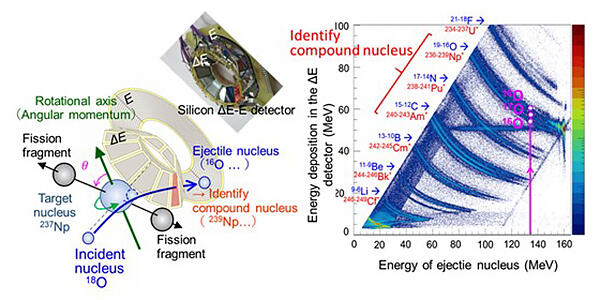Elements up to atomic number 118 are listed in the periodic table, but how many elements can theoretically exist? JAEA Advanced Science Research Center student trainee Shoya Tanaka (also a graduate student at the Graduate School of Science and Engineering, Kindai University), Assistant Principal Researcher Kentaro Hirose, Principal Researcher Katsuhisa Nishio, and Professor Yoshihiro Aritomo for the first time succeeded in experimentally determining the angular momentum that is given to nuclei generated via the multinucleon transfer reaction, a type of nuclear reaction. Principal Researcher Nisiho said that "We are currently proceeding with experiments that use new measuring devices. By accumulating experimental results, we hope to construct a theory that leads to an 'island of stability' and to clarify the extent to which elements can exist." The paper detailing these results was published in Physical Review C.
In the natural world, elements with atomic numbers 1 (hydrogen) to 94 (plutonium) have been confirmed, and humanity has succeeded in artificially producing elements, such as atomic number 113 (nihonium), up to atomic number 118 (oganesson) by using heavy ion accelerators. There is currently global competition aimed at synthesizing the eighth row of the periodic table for elements of atomic number 119 and above. The region where atomic nuclei stably exist is the region where the magic number of protons (2, 8, 20, ...) and the magic number of neutrons (2, 8, 20, ...) overlap. Therefore, it is necessary to reach an island of stability that simultaneously realizes 114 to 120 protons and 184 neutrons, which has not been achieved to date, and to investigate the structure of the atomic nuclei that exist there. However, the number of neutrons is insufficient in conventional methods of fusing atomic nuclei, and it is not possible to reach an island of stability. As such, attention is being paid to the multinucleon transfer reaction.
The multinucleon transfer reaction is one of the processes that occur in the collision of atomic nuclei, and it produces neutron-rich nuclei by exchanging multiple neutrons and protons. In this process, if the angular momentum of a compound nucleus (merger of an incident nucleus and a target nucleus) is too large, then the nucleus will collapse due to fission, and, because neutron-rich nuclei are formed when the angular momentum is small, it is necessary to have good control over the compound nuclei's angular momentum. However, up until this point there had been no detailed measurements of the angular momentum in multinucleon transfer reactions, and, in particular, there were no examples of investigating changes in angular moment with respect to the number of neutrons and protons that are transferred.
The research group irradiated a neptunium-237 target with an oxygen-18 beam that was obtained from a tandem accelerator, and, using a ΔE-E silicon detector that had been developed, the research group observed the traveling direction of the nuclei after the reactions. When fission of compound nuclei occurs the fission fragments are ejected. If the compound nuclei are not rotating, then the fission fragments are scattered in all directions, but, if the compound nuclei are rotating, that is to say, if angular momentum was imparted to the compound nuclei, then many of the fission fragments are emitted in directions that are 90 degrees from the axis of rotation. This was observed experimentally, and the research group confirmed that angular momentum was imparted to the compound nuclei.

Provided by JAEA
Next, when the angular-distribution data obtained from the fissioned pieces was examined, it was found that the angular momentum largely increased for neptunium-237, 238, and 239, in that order. Further analysis of plutonium-238, 239, and 240 and americium-239, 240, and 241 showed that the angular momentum increased with the number of neutrons and protons that were transferred, and, while the number of neutrons and protons that are transferred is small, if their number exceeds three then the angular momentum will saturate. The occurrence of angular momentum saturation indicates that the possibility of forming neutron-rich compound nuclei may be easier than has been predicted by theories so far.
This result gives important insights into clarifying the mechanism by which angular momentum is imparted and is a step that gives guidance for generating nuclei in the undeveloped regions towards islands of stability.
This article has been translated by JST with permission from The Science News Ltd.(https://sci-news.co.jp/). Unauthorized reproduction of the article and photographs is prohibited.




